Wide-bandwidth mode-locked laser
a mode-locked laser and wide-bandwidth technology, applied in the direction of laser details, laser optical resonator construction, optical resonator shape and construction, etc., can solve the problem of relatively narrow wavelength range (spectral bandwidth) provided by such lasers, and achieve the effect of wide combined gain spectrum
- Summary
- Abstract
- Description
- Claims
- Application Information
AI Technical Summary
Benefits of technology
Problems solved by technology
Method used
Image
Examples
Embodiment Construction
[0010] Reference herein to “one embodiment” or “an embodiment” means that a particular feature, structure, or characteristic described in connection with the embodiment can be included in at least one embodiment of the invention. The appearances of the phrase “in one embodiment” in various places in the specification are not necessarily all referring to the same embodiment, nor are separate or alternative embodiments mutually exclusive of other embodiments.
[0011] Mode locking is a method of obtaining ultra-short optical pulses from a laser that is called a mode-locked (ML) laser. The optical cavity of an ML laser contains an active modulating element (e.g., an optical modulator) or a nonlinear passive modulating element (e.g., a saturable absorber) or both, which causes formation of one or more ultra-short pulses circulating in the laser cavity. Each time a circulating pulse hits the output coupler (e.g., a partially transparent mirror), light is emitted from the laser, thereby pro...
PUM
 Login to View More
Login to View More Abstract
Description
Claims
Application Information
 Login to View More
Login to View More - R&D
- Intellectual Property
- Life Sciences
- Materials
- Tech Scout
- Unparalleled Data Quality
- Higher Quality Content
- 60% Fewer Hallucinations
Browse by: Latest US Patents, China's latest patents, Technical Efficacy Thesaurus, Application Domain, Technology Topic, Popular Technical Reports.
© 2025 PatSnap. All rights reserved.Legal|Privacy policy|Modern Slavery Act Transparency Statement|Sitemap|About US| Contact US: help@patsnap.com



